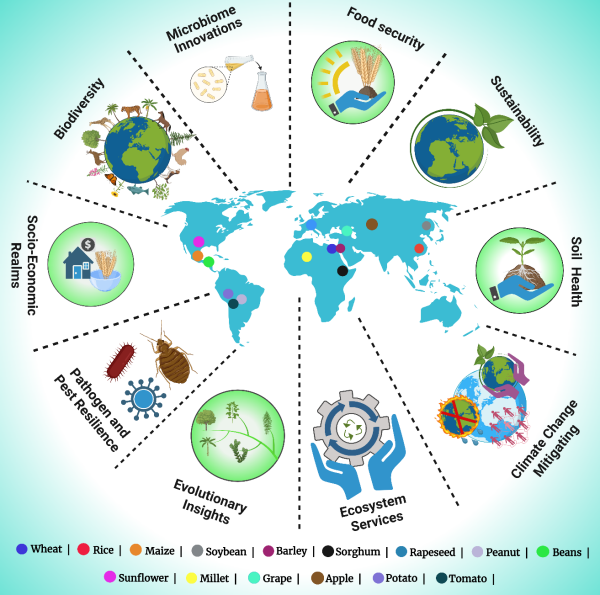Study Highlights Vital Role of Crop Wild Relatives and Their Associated Microbiomes for Sustainable Agriculture
2025-07-16
A recent study has illuminated a critical yet often overlooked dimension of global food security, the vital role of crop wild relatives (CWR) and their associated soil microbiomes in building resilient agricultural systems. The study was published in Nature Communications.
The research team, spanning institutions across Germany, China, the United States, Italy, Sweden, Canada, and Australia, synthesized evidence from multiple disciplines to demonstrate how agricultural domestication has inadvertently disrupted beneficial plant-microbe relationships. Using examples from wheat, rice, maize, and soybean, they showed that modern crops have lost many of the microbial partnerships that helped their wild ancestors thrive in challenging environments.
The researchers led by Dr. Muhammad Waqas, now working in Prof. CHEN Yaning's group at the Xinjiang Institute of Ecology and Geography, Chinese Academy of Sciences, position CWR as "guardians" of adaptive microbial diversity that could revolutionize modern agriculture. They highlighted that these wild plant species, which are the evolutionary ancestors of our cultivated crops, harbor sophisticated microbial communities that have co-evolved over millennia to provide enhanced stress resilience and resource-use efficiency.
Plant-associated microbes are increasingly recognized as a "second plant genome" due to their fundamental roles in plant nutrition, water uptake, defense, and resilience against environmental stressors. This recognition has profound implications for addressing climate change impacts on agriculture.
The study revealed that domestication has shifted plant microbiomes and often reducing beneficial functions such as nitrogen fixation and pathogen suppression. In wheat, for instance, domestication led to depleted bacterial biocontrol capacities against pathogenic fungi compared to wild ancestors.
To address these challenges, the researchers propose establishing "CWR Biodiversity Sanctuaries" – conservation hubs designed to protect both wild plant species and their associated microbiomes within naturally evolving ecosystems. These sanctuaries would serve as living laboratories for understanding plant-microbe interactions while preserving invaluable genetic and microbial resources for future agricultural applications.

Benefits of in situ conservation initiatives for crop wild relatives (CWR) and their microbiomes. (Image by Muhammad Waqas)
The team identified several promising research directions, including the development of synthetic microbial communities (SynComs) derived from CWR-associated microbes, and the identification of plant genes that regulate beneficial microbial associations. They also emphasized the potential of analyzing root exudate profiles to understand how plants selectively recruit beneficial microorganisms.
This study provides a comprehensive yet concise and crucial roadmap on how to establish CWR initiatives for conserving, using, and sharing crop wild relatives and their microbiomes, along with essential guidance for scientists, policymakers, and conservation organizations working to develop more sustainable and resilient food production systems amid increasing environmental challenges.
Read the full article: https://doi.org/10.1038/s41467-025-61779-x
Contact
LONG Huaping
Xinjiang Institute of Ecology and Geography
E-mail: longhp@ms.xjb.ac.cn
Web: http://english.egi.cas.cn



